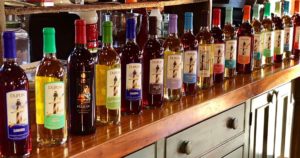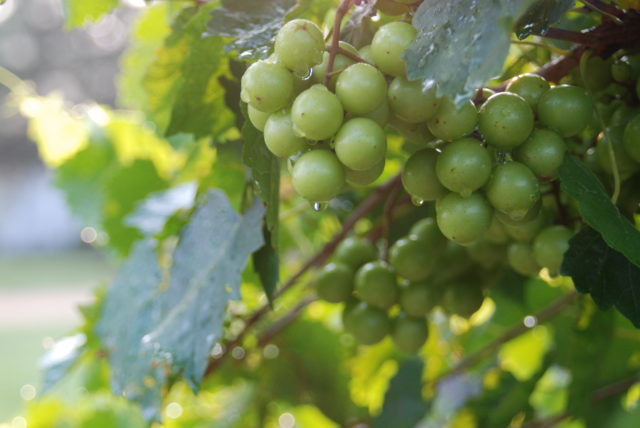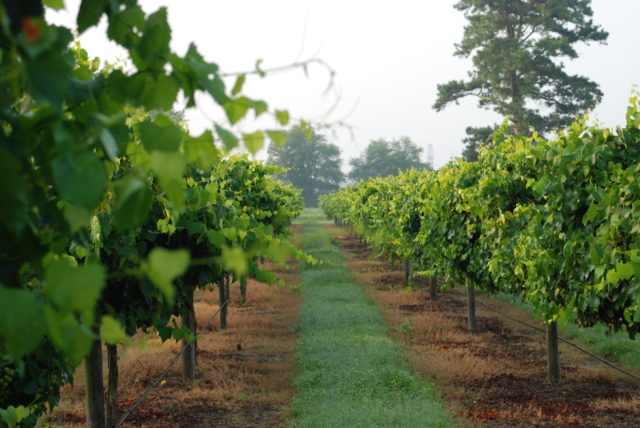By Paul Vigna
That Duplin Winery in eastern North Carolina is included among the country’s top 50 producers, according to Wine Business Monthly’s February 2021 issue, wouldn’t surprise anyone who lives in the state. The wines are found on grocery store shelves everywhere, from Southport on the coast to Elkin in the mountains.
While it doesn’t share the same national profile as many of the others on that list, the family-run business has carved out a regional niche as a producer of primarily sweet wines made from the Muscadine grape.

Twenty years ago, Duplin was making 30,000 cases and selling in one state. Production enhanced when a second location in Myrtle Beach, South Carolina opened six years ago. Today, Duplin produces 560,000 cases of Muscadine wines annually, selling in 15 states. A third, Florida-based site (which recently broke ground) may increase production by more than 25 percent, says Dave Fussell Jr., the winery president and founder D.J. Fussel Sr.’s son.
The Fussels attribute Duplin’s success to their focus on Muscadine, a native American grape that has called the Southeast its home for more than 400 years. The grape is less susceptible to rot and disease, making it ideal for that region’s heat, high humidity, and tropical rains.
According to Mark Hoffmann, a small fruits specialist with NC State Extension, there are approximately 50 Muscadine cultivars, though just four or five are exclusively used for winemaking. The most prominent is a bronze cultivar called Carlos, used for around 80 percent of the Muscadine wine produced. “It’s very vigorous and very high yielding,” Hoffman says. “It does not need a lot of management in the vineyard.” Production can be as high as 10 to 12 tons per acre, he says.

Other popular cultivars include two other bronze grapes, Doreen and Magnolia, and a dark grape called Noble. Duplin also makes wine out of a Muscadine cultivar called Scuppernong, well-known because the “mother vine” continues to grow on Roanoke Island, North Carolina.
Both red and white Muscadine wines are medium-bodied with medium to high acidity and very fruit-forward.
Much has been written about the health benefits of Muscadine grape extracts because of high levels of polyphenols (antioxidants), resveratrol, and ellagic acid in Muscadine skin, seed and pulp. Those substances are currently being explored as a cancer therapy. It’s also a grape that figures potential growth on the fresh-market side, with advances in creating more seedless varieties.
Duplin is the largest Muscadine winery in the world. With a tank capacity of 2.4 million gallons, the variety makes up 100 percent of its case production. Though its reputation is for sweet wines, not everything it makes is sweet. Fussell Jr. can be found alongside his wife Angie on a company video touting Duplin Burgundy, a dry blend.
Still, it’s the ocean of inexpensive sweet whites and reds that have won Duplin a mix of accolades, including Impact’s Hot Brand Award and a long list of competition medals, and a growing loyal following.
“Our true reward is being able to sell seven million bottles of wine [annually] because people are buying and drinking it,” Fussell Jr. says. “That means they like it.”
Duplin itself grows around 200 acres of Muscadine grapes, which is just 9 percent of what it uses. The remainder comes from regional farmers.
“My father always said the best fertilizer in a vineyard is the shadow of the owner,” says Fussell Jr. “We’re trying to put ownership into growing grapes, so we contract with farmers who own the land and take pride in what they are doing.”
Duplin isn’t the only winery that uses the Muscadine grape; others, from Tennessee to Florida, include it in their portfolio.
In North Carolina, Tina Smith says that she and her husband Don opened Cypress BendVineyards in 2002 to “create the best representation of Muscadine wine in N.C.” It’s located around 90 miles southwest of Raleigh. “We have always regarded the Vitis rotundifolia grape as a significant wine grape and wanted to present the true essence of the grape in our winemaking,” Smith says.

Their winemaker, Nadia Hetzel, is helping make that happen, Smith comments, by “treating the Muscadine grape like the Riesling grapes she worked with in Germany because of their [high] acid similarity and fruitful flavor.”
Cypress Bend, an annual producer of 10,0000 cases of Muscadine, is a five-time winner of the Muscadine Wine Cup.
William “Biff” Yost opened Cauble Creek Vineyard in Salisbury, around 40 miles northeast of Charlotte, N.C., in 2010. He is making wines from the Carlos, Noble, and Doreen cultivars, but also testing seven others as well as experimenting with blends, including those utilizing various vitis vinifera in the mix.
With so many cultivars of Muscadine, Yost says, “You can create a lot of boutique wines that are nice for the palate for both sides, the sweet wine drinkers and also the standard [dry] wine drinkers.” Cauble Creek produces around 1,000 cases of Muscadine annually.
Still, much of North Carolina continues to focus on more conventional wine grape varieties (Cabernet Sauvignon, Chardonnay, Viognier). But Duplin’s extensive list of Muscadine wines, along with notable production from a few other producers, will make Muscadine an integral part of the state’s wine industry long term.
And, as Hoffmann notes, “with improved winemaking technology and the use of non-traditional Muscadine cultivars,” there’s high potential for Muscadine’s future in the Southeastern wine industry.




